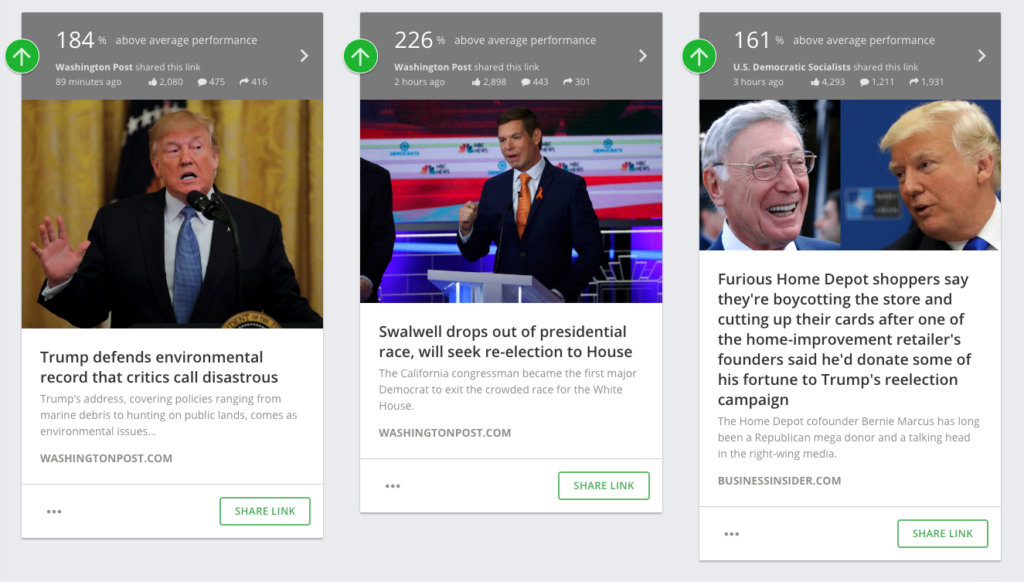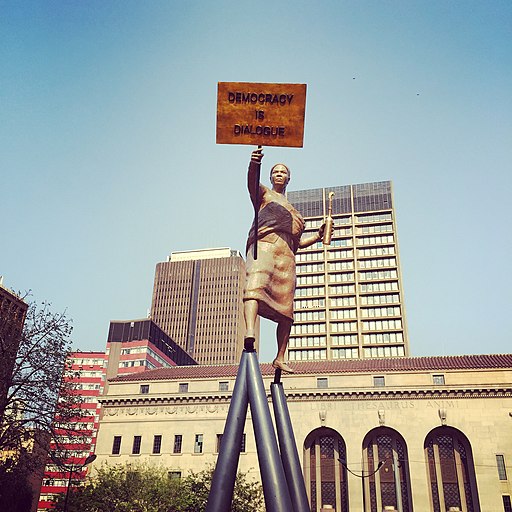Why Educating Policymakers Is Not Enough
There's an interesting new article up at Texas National Security Review on policymaking, and specifically on policy "competence." Titled "To Regain Policy Competence: The Software of American Public Problem-Solving," the article laments the decline of policy education at the highest levels of elite and civil service-based training in governance, and its author offers a comprehensive set of reforms in university training of policymakers.
It's understandable that this has become a concern: the so-called populism that we are told is driving the current political moment brings with it (not in every instance but in more than a few) a thumbing-the-nose at policy expertise. The author of the TNSR article, Philip Zelikow, says there's been a decline in policymaking skills going back much further than the past three years; I'll leave it to others to weigh that data.
Whatever the case, the author is optimistic that "[t]he skills needed to tackle public problem-solving are specific and cultural — and they are teachable." Zelikow uses the metaphors of "hardware" and "software" to describe the tools required for nations and governments to implement good policies. Hardware is the structure of government (and, I would imagine, the material things needed to carry out policies). Software is the culture of education and decisionmaking that goes into training, acclimating, and facilitating policies and policymakers.
Good software, Zelikow says, can compensate for bad hardware. "For instance," he writes, "amid all the public controversies about law in America, the United States still does reasonably well upholding the rule of law and the administration of justice. Why? One reason is because the American legal profession has established very strong norms about what constitutes appropriate legal reasoning and quality legal research and writing. This is software." It's true that in spite of crisis after crisis at national and local levels, we still haven't seen the total breakdown of law and order in society. But, as I will suggest below, the reason policy regimes succeed isn't just the respect that legal practitioners have for the standards of their profession: it's also that constituents still trust most of the fundamentals of the rule of law. If they didn't, all the legal training in the world wouldn't be enough to compel the non-legally trained people to obey the law.
But the bottom line in Zelikow's article remains lack of training, or improper training, as the cause of current policy incompetence. He has a good point, particularly historically, that such training matters. It was training, he writes, not only in the philosophy of civic virtue but in the incorporation of the right amount of technical knowledge into policymaking, that helped the Allies win the Second World War: "The Allied successes included extremely high-quality policy work on grand strategy, logistics, and problem-solving of every kind. The German and Japanese high commands were comparably deficient in all these respects."
So I also agree with Zelikow that the evolution of this broad-based approach into mere "economics, statistics, and quantitative analysis" in the latter half of the 20th century was an unfortunate descent. But I would offer up that the comprehensive curricular reform suggested in that article will itself simply devolve into hyperspecialization eventually without the check of citizen deliberation.
Constituents and stakeholders are also hardware, and building a culture of interaction and participatory democracy is software. One important piece of the deliberative model is its distinction between constituents and consumers. As Tony Greenham writes, "Consumption implies a passive acceptance of what is on offer. Although we have a choice, it is within a narrow envelope of options within a fixed system. In contrast, citizenship brings a sense of ownership and agency over the system itself." The bottom line is that deliberation creates a better policy because those who are affected by the policies get to have a say in their creation and implementation.
Deliberation in the form of proactive constituent engagement can also check back on groupthink. A great case study about the dangers of groupthink is the tragic explosion of the Space Shuttle Challenger in 1986. And that particular manifestation of groupthink, inspired as it was by the imperative of the "political victory" of NASA looking good and the Reagan administration being able to celebrate a technological victory, suggests that an exclusive focus on better policy education on the part of leaders is not enough.
Engineers from Thiokol had teleconferenced with NASA management about 12 hours before the launch of the Challenger. The engineers expressed their concern that lower temperatures at the launch site had created icicles. The engineers had already been concerned about the integrity of the O-rings on the craft. NASA rejected those concerns and judged the risks appropriate.
Of course, groupthink results in thousands of mini-disasters, and occasionally bigger ones that mirror the magnitude of a deadly spaceflight disaster, in the worlds of national, state, and local policymaking. Even teaching leaders to question themselves, or organizational structures to question their own conclusions, may not be enough. What is needed is the perspective of those "outside" the decisionmaking body who aren't really "outside." This means constituents, stakeholders. Creating two-way, multi-way, collaborative platforms for constituent communication hardwires deliberative disruption. Disruption is the nutrient of democracy.
So while I think it's great that we're talking about better leadership training, more robust civil service education, and creating holistic education for those who draft and implement policies, we also have to keep talking about the points of engagement between them and those they serve. That's why software companies build government CRM solutions to manage these constituent communications at scale.
Doing Data & Education Well
Done correctly, big data can make education better. Pritom Das just posted three significant changes in education policy and practice driven by data innovation. They include personalization (tracking student behaviors and preferences to develop customization technology), increased participation, and better measurement of performance. I think the most promising of those is participation. Like personalization, the idea is to develop platforms that customize with (not just for) the student.
The most concerning and complicated of these is surely performance assessment. It has the most potential for unreflective, mostly quantitative assessment of student performance. If the collection of data is especially cold and impersonal in certain contexts, it doesn't matter whether the data is being accumulated slowly or quickly.
The motive of many education policymakers is undoubtedly to use performance data to improve learning systems, but each factor, including temporal questions like how long students take to answer test questions, how many times they read a text or watch a video, or whether they go over learning materials many or few times, obscures why different students would choose to do these things. I may go back over the material multiple times for reasons other than a deficit in immediate understanding; I may gain a deeper, more synthesized understanding precisely because I go over something more than once intentionally.
It's really a matter of what questions are asked and who is studying the answers, of course, but too much emphasis on how long it takes a student to learn something (honestly, do we care about temporal efficiency that much? are we that Fordist?) risks less attention being paid to questions like social class: where mountains of research (enhanceable by good metadata, of course) demonstrates that "children’s social class is one of the most significant predictors—if not the single most significant predictor—of their educational success." The research also shows that these class differences affect kids at the earliest stages of education and then "take root" and "fail to narrow" over time—creating large gaps in cognitive and noncognitive development that translate into hundreds of thousands of dollars and countless quality of life factors. It's really a terrifying indictment of the American education system.
The concern is that because of the emphasis on speed of learning or the desire to complete steps, lots of otherwise good educational advocates stop asking tough questions about data-driven education. Lots of otherwise good outcomes may also be suppressing individuality, papering over class, race, or gender inequality, not meeting kids' and families' needs.
These concerns, and a few more, were expressed in a post last summer by Rachel Buchanan and Amy McPherson at the Australian site EduResearch Matters provocatively titled "Education shaped by big data and Silicon Valley. Is this what we want for Australia?" The tying of potentially beneficial technology to a particular business interest (whatever that interest) evokes a frustration that we have lost a compass for tech serving the common good. The authors point out that the "products" being introduced measure "not just students' learning choices but keystrokes, progression, and motivation. Additionally, students are increasingly being surveilled and tracked." The post quotes a poem by education blogger Michael Rosen:
"First they said they needed data
about the children
to find out what they’re learning.
Then they said they needed data
about the children
to make sure they are learning.
Then the children only learnt
what could be turned into data.
Then the children became data."
I think many folks I know who think about big data a lot would like to see a world where we used it to improve education in the right ways and not think so much about students en masse in these kinds of cause-and-effect relationships. One solution, given that the data genie isn't going back into the bottle (and has the potential to help fight inequality while also building individuality) is to teach students precisely what's happening to them, to pull back the curtain, to show them the gears and scaffolding of education policy itself—as well as its quantitative assessments. I mean things like teaching middle school students, for example, how AI works ideologically, not just technically. This is the focus of a suggested curriculum outlined by a professor and two graduate students at MIT, "Empowering Children through Algorithmic Justice Education."
The proposal calls AI education "an issue of social justice - it is not enough to teach AI or machine learning as a technical topic." It cites the findings that "neutral" data can actually be biased, requiring the teaching of ethics "in conjunction with AI as a technical topic." The question to be asked: who are we building this technology for? Ongoing efforts to examine and develop industry ethics in quantitative data are also important and encouraging.
Whether you feel like data should be idealized to be objective and neutral, or seen as reflective of human biases rather than overcoming them, watching videos like this will make you think about what kind of world we want to build with the literal quantum leaps we're making in the field.
And as you might imagine, such ethical and social questions also haunt the use of data in political and issue campaigns, including the ways we append that data with additional information using vendors like our client Accurate Append, an email, and phone contact data quality vendor. We should always be self-reflective—and other-reflective—in the way we ask even seemingly neutral demographic or profile questions.
Big (and Fast) Quantum Data
"Of all the theories proposed in this century," physicist Michio Kaku wrote in Hyperspace, "the silliest is quantum theory. In fact, some say that the only thing that quantum theory has going for it is that it is unquestionably correct."
Last month, our client Accurate Append, an email and phone contact data quality vendor, blogged about a big space data conference, and described promising developments in the use of data analytics to measure greenhouse gases based on satellite imagery, to identify organic molecules and methane on other planets and moons (critical to the search for the origins of life) and more.
But how about a deeper dive into something even more complex? The particles (like photons and electrons) that make up the substance of the universe behave in really strange ways if we look at them closely. They have a "reality" very different from classical descriptions of matter as stable and consistent. Understanding that strange behavior—and then even harnessing it, or flowing along with it—is the challenge of applying quantum theory, and this has world-shattering implications for big data and artificial intelligence, to say the least.
It really depends on who you ask, of course, whether this is a good thing. Shouldn't we be able to break codes used by criminals or terrorists? We may be heading into a brave new world where security and insecurity co-exist along with the on, off, and on-off of quantum states. An expert in "Ethical Hacking" said back in 2014 that told Vice in 2014 that "the speed of quantum computers will allow them to quickly get through current encryption techniques such as public-key cryptography (PK) and even break the Data Encryption Standard (DES) put forward by the US Government."
In the most oversimplified of nutshells, quantum computing goes beyond the binary on/off states computer bits normally operate under, adding the additional state of on and off. The main consequence of this third state is that quantum computers can work "thousands of times faster" than non-quantum computers—beyond anything that could be otherwise imagined. That speed also adds to the security of quantum data. Experts call it un-hackable, which is pretty audacious. Some of the basic everyday miracles of quantum physics also make their way into quantum computing, like "entangled" particles being changeable together even if they are far apart. This provides a way of essentially "teleporting" data—transferring it without fear of being intercepted. Chinese scientists seem to have taken the lead on the un-hackable quantum data plan. Since there is no signal, there is nothing to intercept or steal. To put it in even simpler terms, the data being shared is, in a sense, the same data. It's like existing at two distinct points in the universe simultaneously but only as one unit. More precisely, you've created a pair "of photons that mirror one another." This indeterminacy leads to the possibility that many of the "laws of science" we take for granted are just arrangements of things in relation to other things. Gravity itself, and many of the behaviors of space and time might actually be "correcting codes" at the quantum level.
Qbits, which are these nonbinary computer bits we're talking about, can be made by superconductors that maintain a quantum state. This requires extremely cold temperatures—close to absolute zero; colder than the vacuum of space. Underlying these miraculous evolutionary steps is the quantum theory's embrace of "imprecision" in a computing world that has mostly relied on precision and predictability. This makes quantum theory natural kin to artificial intelligence since AI aspires to teach computers how to "handle" and process imprecision.
In some ways, embracing imprecision in computing technology is similar to the implications of philosophers rejecting binarism in the 19th and 20th centuries. Georg Wilhelm Friedrich Hegel, for example, in the early 19th century, developed the dialectic to do justice, as many of his interpreters have put it, to the reality of the half-truth, to the idea that things may be in a state of development where they are neither and both one thing and/or another. In a very different way, the Danish theologian Soren Kierkegaard sought the rejection of absolutes and the embrace of absurdity, a kind of simultaneous being-and-non-being. Werner Heisenberg, one of the founders of quantum theory, seemed more like a philosopher than a scientist when he wrote "[T]he atoms or elementary particles themselves are not real; they form a world of potentialities or possibilities rather than one of things or facts."
The implications for big data are immeasurable because quantum computing is to nonquantum computing what the speed of light is to the speed of sound. "Quantum computers," says Science Alert, "perform calculations based on the probability of an object's state before it is measured - instead of just 1s or 0s - which means they have the potential to process exponentially more data compared to classical computers." All of this culminates in Lesa Moné's post on quantum computing and big data analytics. With quantum computers, Moné writes, the complex calculations called for by such analytics will be performed in seconds—and we are talking calculations that currently take years to solve (and are sometimes measured in the thousands of years). Quantum calculations will change the very nature of how we view the interaction of time and information processing. It's something on par with the discovery of radio waves, but given that we'll be crunching years into seconds, the social impact may be much, much larger.
Data, Election Hacking, and Paper Ballots
Thomas Paine wrote that "the right of voting for representatives is the primary right by which other rights are protected." Taking away that right reduces us "to slavery" and makes us "subject to the will of another." Regardless of whether you're on the left or right, Americans value that kind of autonomy—that we choose the rule makers and enforcers, that we periodically get to choose new ones and whether to retain incumbents. How to protect the integrity of that process, so that its outcomes actually reflect our conscious preferences, seems to be as important a question as any that law and policy makers could ever ask in a democracy.
Data and its processing are commodities and conduits of power, and because of this, there will always be attempts to steal and manipulate them. Our SEO client Accurate Append, a phone, address, and email contact data vendor, recently wrote about the danger of fake data, and hacked elections are a manifestation of the same overall aim: to distort the will of voters and undermine people's participation in civil society.
For people who work on improving the electoral process, and those of us offering services for candidates and leaders to better reach voters, this is also a question of professional importance. It's personally frustrating for those who offer data, analytics, other informational services that help campaigns learn more about their constituents. Hacking undermines the effort to construct electoral strategies commensurate with the needs and perspectives of the real people who are voting.
News media is buzzing that Senate Majority Leader Mitch McConnell is blocking legislation to address election hacking at the federal level. And states are not moving either. The Verge reports that although progress has been made on moving back to paper ballots (only 8 states remain paperless now compared to 14 in 2016), "most states won’t require an audit of those paper records, in which officials review randomly selected ballots—another step experts recommend. Today, only 22 states and the District of Columbia have voter-verifiable paper records and require an audit of those ballots before an election is certified." As we'll shortly explain, that extra verification step is necessary because even paper ballots are vulnerable to manipulation.
Much of what we know about the ability to hack into things like elections is due to the efforts of organizational hacking conferences like DefCon, which gathers experienced hackers at conferences to discuss the ways that security may be open to breach.
The work they do, which was featured at a recent annual conference, is fascinating. In addition to election hacking, which we're discussing here, hackers and scholars of hacking research things like whether AI and robots are subject to sabotage via electromagnetic pulse (EMP). It all feels very James Bond. But the most immediately relevant stuff is voting machines, systems, and databases—all set up as the "Voting Village" at the conference, with the aim of promoting "a more secure democracy." These "good guy" hackers find ways to remotely control local voting machines, "the innards of democracy," so that the public can be aware of potential threats and constantly demand solutions. As one hacker put it, "these systems crash at your Walmart scanning your groceries. And we're using those systems here to protect our democracy, which is a little bit unsettling. I wouldn't use this . . . to control my toaster!"
This work is important even if all states switched back permanently to paper ballots, because some kind of technological facilitation, intervention, and processing is inevitable, and as long as such activity contains data shared between machines, it's subject to outside sabotage or manipulation. Freedom to Tinker has an outstanding list of the ways this could happen in a paper system. Hackers could hack the software used in the auditing and recount processes, and avoiding the use of computers during that process is impractical in contemporary society. "For example, we may have print a spreadsheet listing the “manifest” of ballot-batches, how many ballots are in each batch; we may use a spreadsheet to record and sum the tallies of our audit or recount. How much of a nontrivial “business method” such as an audit, can we really run entirely without computers?"
Of course, as the article adds, one could simply manually manipulate the recount process with a "bit of pencil lead under your fingernail," but at least at that point there would be people to catch locally doing such things. The call for "careful and transparent chain-of-custody procedures, and some basic degree of honesty and civic trust" is easier to enforce in person than across bytes, air, and cables. In the meantime, though, paper ballots aren't perfect, but they are the cornerstone of addressing current threats to election integrity.
Healthcare Staffing Is the New Data Commodity
If you have nursing credentials, and are willing to travel to meet the ever-shifting (and ever-growing) demands of healthcare providers, chances are that your contact information will be part of varying bundles of data bought, sold, or traded by nurse recruiting websites. This isn't necessarily a bad thing—and it's a subject I think about a lot since my SEO client Accurate Append is in the business of providing the most accurate email, cell phone, and landline contact data.
Healthcare professionals are the gold standard of the contemporary tight professional labor market. Healthcare CEOs list their biggest rising expense as the money they spend competing for talent. Hiring rates are incredibly high now and are expected to either stay the same or even grow in 2019. According to the "Modern Healthcare CEO Power Panel survey," about 75 percent of CEOs responded that "front-line caregivers are most in need." No wonder the unemployment rate for practitioners is only 1.4%, while the rate for assistants and aides, higher at 3.4%, is still well below the typical 4% unemployment rate. If you want to be in demand, be a healthcare professional.
And if you want to be in even higher demand, be a Registered Nurse (RN) who can travel. These stats are unbelievable. RN employment overall will grow 15 percent over the next 8 years—higher than pretty much any other profession. Travel nurses are hired on contract to fill temporary gaps in nursing, and the industry is benefiting from increasing participation by states in the Enhanced Nurse Licensure Compact (eNLC).
The recruiting game for these (often highly-specialized) travel nurses is in full steam. Kyle Schmidt of the Travel Nursing Blog has a fascinating piece on the emerging market for the personal contact information of nurses who make themselves available for travel services. This demand is met by gathering data from prominent services like travelnursing.org, travelnursesource.com, rnvip.com and others, but it's also met by more traditional healthcare staffing companies which, although they don't sell contact information to their partners, simply generate their own leads to fulfill their clients' needs.
When this data is collected via the web, it's done through website visits where visitors are encouraged to provide their contact information. Those sites are using old-fashioned, but reliable, methods of getting people there: Kyle points cites stats by Conductor, a digital marketer, that "47% of all website traffic is driven by natural search while 6% is driven by paid search and only 2% is driven by social media sites." Paid advertisements are virtually ignored in comparison to naturally clicked links, while "75% of search users never scroll past the first page of search results."
How are nurses convinced to provide their contact info? The answer is through the advertisement of "broadcast services," which promise to provide candidates' information and availability to agencies. The business model works even if the broadcast service doesn't get a lot of money for providing the data, because the web sites are very basic, often managed through content-management systems, and don't need to be heavily maintained.
This steady (and often high-speed) increase in recruiting needs is part of maybe the longest term employment trend in the U.S. today. Hospitals have been using contract labor to fill in for massive nursing labor shortages at least since the late 1990s. Over a million and a half jobs were added from 2004-2014, and as we know, these vacancies kept growing in the last five years. A June 2019 market research report sheds some interesting light on the healthcare recruiting industry--some facts that might explain why the recruiting game for nurses seems so data-driven (and dependent on contact info-fishing at such a volume-driven level). While we know the labor market is competitive, what we do not know is whether particular states and regions will have consistent demand for nurses. This is because, while we know government spending on Medicare and Medicaid is expected to increase in 2019, the ongoing political volatility around healthcare spending means that there may be bumps in the road, unexpected windfalls in unexpected places, and unexpected losses of funding as well.
All of this leads me to ask whether contact info data collection and distribution for the nursing industry might be streamlined and made more efficient over time. We know that hospitals' human resources departments "use analytics for recruiting, hiring and managing employees," but there's a divide between how big and small facilities collect and manage this data. According to the Nurse.com blog, big hospitals "have sophisticated human resource management systems for employee records and talent management, while small facilities and clinics often rely on free analytics tools such as job sites, email clients and search engines"—analytics tools provided by sites similar to the data collection and distribution sites mentioned earlier.
Leadership as Dialogical Communication
South African artist and sculptor Lawrence Lemaoana has a piece called "Democracy is Dialogue" standing in front of old Johannesburg City Hall. The statue is of "a woman protester with a baby strapped to her back. She has a protest placard in one hand and a candle in the other to light her way." Lemaoana has been a fierce post-apartheid social voice and was a critic of president Jacob Zuma. President Zuma would often publicly raise his fist, a sign of victory, but for Zuma, a call to silence criticism.
Public communication is not always communication geared toward dialogue. Donald Trump rose to the presidency through, among other things, his aggressive use of Twitter to draw attention to himself and to criticize others. Twitter's simplicity and tendency to vitriol set the tone for Trump's messaging. The communication wasn't multi-directional; it wasn't a tool of dialogue. Nevertheless, "In a 3–0 decision, the U.S. Court of Appeals for the Second Circuit held that President Trump's practice of blocking critics from his Twitter account violates the First Amendment." What Trump thought was a bullhorn at least required him to allow others to scream back at him. Still though, not a dialogue.
But the Second Circuit Court's rationale for the decision draws from a more civic-minded philosophical well: because Trump's Twitter account was a government account—official seal, held up as such, "with interactive features accessible to the public"—the First Amendment was relevant and in need of protection. After all, as the court points out, "not every social media account operated by a public official is a government account," so if Trump had wanted to rant without response, he could have done so on an account not specifically identified as governmental. He even arguably could have done so on his reelection campaign accounts. "The court found that President Trump, therefore, 'is not entitled to censor selected users because they express views with which he disagrees.'"
The underlying philosophical principle is just as important as the legal distinction. That underlying principle is that public, government-mediated communication with public officials is dialogical. Dialogical means having the "character of dialogue," a discussion between two or more individuals.
That's a profound distinction, even if it comes off as functional and factor-based in the court's analysis. Democracy is a process, but it's also an approach. For proponents of more participatory democracy, that approach is, among other things, dialogical—based on ongoing conversations between officials and their constituents.
But even though a court can rule that people have a right to tweet back to a public official, that doesn't mean doing so constitutes meaningful public or constituent dialogue. Even if there are dialogic elements to social media, its underlying structures and its practices in a mass marketing context may undermine whatever dialogical function it has. Samantha McDonald, who studies how technology mediates communication between citizens and policymakers, writes at her blog: "major social media players like Facebook and Twitter were never designed to be spaces for quality policymaker engagement. Just ask Congressman Rick Crawford, who replaced Facebook with his new texting application. Or Representative Alexandria Ocasio-Cortez, who points out that these platforms are huge public health risk. In addition, why is Congress communicating to constituents through platforms that sell citizen’s data?"
It's important to remember that not all constituent communication is about important policy dialogue (in another piece, McDonald points out that congressional staffers "report that contact can be untimely" or consist of "emotional reactions to government issues that the office cannot help"). But policy discussions with constituents are possible. Focused dialogue which is proactive and "hard-wired" into a deliberative event can result in "diverse participation," particularly if accompanied by "balanced, factual reading material for participants; single topic focus; a neutral, third-party host; and live member participation." Structured communication is also possible through constituent-focused CRMs—designed not for consumers, but specifically to foster official-constituent dialogues over time.
One Quick Trick for Increasing Your Podcast Plays
Back in 2009, I produced and hosted a no-budget podcast about the emerging use of social media in government called “Gov 2.0 Radio.” If I were to do it again today, there’s one tool I’d definitely use to grow my audience: ActionSprout.
During my Gov 2.0 Radio days, Twitter was often how I’d juice exposure for my new episodes and related blog posts. I’d also use Twitter and RSS feeds to gather news about emerging Gov 2.0 trends and often published link roundups. If I’d had a tool that brought the best performing content from Governing, Social Media Today, and the rest of the crumbling Web 2.0 media right to me, with publisher and advertising tools to boot, maybe I’d still be interviewing up-and-coming PIOs to this day.
I’ve worked with ActionSprout for several years, first as an early NationBuilder partner, then to help the company distribute $2 million in Facebook ad credits to nonprofits. Today, I am organizing a network of news and good government organizations to curate and promote quality anti-corruption news on Facebook using ActionSprout’s tools.
If I were podcasting or producing video shows today, I’d simply load a list of Facebook pages for my best sources into ActionSprout Inspirations, sort for the top performing posts each day or week, schedule out my favorites with new commentary, and share the roundup in my broadcasts.
Here’s an example from a list of political sources I’m presently following:

How does following and sharing relevant viral stories help a podcast grow its audience? One, drop a link to your relevant shows into your commentary on a trending story that is going to outperform and reach beyond your fan base. Two, use the ActionSprout Timeline feature to identify your top trending posts on your own page, edit post commentary with a relevant link to your own content, then use ActionSprout’s advertising tools to boost the viral content. Don’t miss the opportunity to repost your best content, either - Facebook will find new, relevant audience for it, not repeat it in your fans’ feeds.
What if you want to collect more information, such as text opt-ins, from listeners? You can use a phone append database from a vendor like Accurate Append with a data append API to validate forms in real time. You can also use ActionSprout’s petition tools to begin building an email list based on your Facebook fans.
Engaging deeply with a listener base, whether through public and exclusive groups (a good example here is Beep Beep Lettuce, which has a public Facebook page, a group for supporters, and a Discord channel for the most hard-core fans), Patreon updates, an email newsletter, or even text subscriptions, is foundational to long-term audience growth.
Join ActionSprout's government accountability network—free for media and nonprofit organizations.
Local Government Transparency as Value Criterion
Stick the word "transparency" into a news database. Limit the search to the past week. You'll pull hundreds of links: letters to the editor on a local government body's lack of transparency. Congressional hearings on transparency in the federal judiciary. Pushes for transparency in health care charges. The applicability of police transparency laws to various police records. Transparency in all levels of decisionmaking that affect the public.
We hear the word "transparency" all the time. It's a "god" term in nearly every aspirational statement of nearly every political ideology. We don't spend a lot of time contemplating those times when transparency might not be the highest value (protecting the privacy of vulnerable people, allowing public officials a little deliberative space rather than reminding them they're always essentially on television, and so on) because we've seen too many instances where secrecy has been abused. Transparency not only has the denotative meaning of openness, but the connotative meaning of: essential for democracy.
Although American legal scholars have long characterized states as laboratories for democracy, a growing consensus is building around municipalities as better serving that space. Municipalities have a disadvantage, resource scarcity, that actually interacts with the advantage of direct contact with constituents—everyone gets to complain and argue about that scarcity together.
What is transparency? According to one extremely in-depth treatment of the topic, "[t]ransparency is understood as the opening up of information on actions and laws to the public, providing citizens with the tools to improve understanding, vigilance, and communication. Coupled with action from the public and media, this should lead to accountability where public officials take responsibility for their actions (or inaction)."
We hear a lot about how technology aids secrecy—and it certainly does. But technology also supercharges the potential of governments ethically committed to transparency. As Catherine Yochum points out, technology has made direct participation easier than it's ever been in history. It allows citizens to participate from their homes, it facilitates the establishment of what Yochum refers to as "community dashboards." Cities looking to implement these sort of systems should seek out CRM and data analysis software built specifically for government.
Although accessing these platforms requires investments from the jurisdictions that use them, the technologies involved aren't just commodities. So when Yochum writes that municipalities "are, for lack of a better word, 'competing' against other cities for residents, businesses, tax dollars, state grants, and federal grants,' I don't know if the competition metaphor is wholly appropriate. People don't choose where to live like consumers choose products from vendors—at least the vast majority of people don't. And relationships between cities are part of creating political geographies that work for people in a complex, economically insecure, and interdependent material landscape. In fact, cities and counties can work together for even greater transparency and efficient information delivery than they could alone, perhaps using joint powers authority like the kind that exists in California. Speaking of California, the state has other transparency-facilitating advantages as well: a robust home rule law, as well as being the pioneer of the Public Records Act, enacted in the late 1960s, requiring "municipalities to disclose government records to the public."
Finally, U.S. municipalists can look internationally to see how voters and residents can empower themselves using transparency tech. Kenyans are enacting tech fixes to make proceedings of parliament more accessible. Jordan—a monarchy—is involving citizens in direct decisionmaking via a system called Ishki. Chile has the very nicely named Vota Inteligente, "informing Chilean citizens about corruption and policy debates through the use of social media." Seoul has its own corruption reporting systems, while Peru, Russia and Germany have all adopted constituent conversation systems. And "[i]n India, technology and independent mass media has also allowed people to put pressure on the government to act against corruption and be more transparent . . . in Mumbai a number of groups of 'activists, geeks, data people, lawyers and techies' hold 'datameetings' to discuss how data and technology can be used transparently."
Transparency is seen as a core value—that is, a value that informs other values and policy criteria. It's really a synthesis of the right to know with freedom of expression, as either of those values by themselves would be meaningless without the other. Both of these are enhanced by technology in accountable hands.
Google and the Right to Be Forgotten
The "Right to Be Forgotten" doctrine is controversial in the United States in ways that frankly surprise most Europeans. The latter are used to the eternal complex struggle to balance the rights of individual and community, and are not used to the deference given in the U.S. to large corporations. So when a "leading French consumer group filed a class-action lawsuit" last week "accusing Google of violating the European Union's landmark 2018 privacy rules," this hardly raised an eyebrow in the European press, but plenty has been said about it in Google's home country.
The lawsuit was filed in an administrative court in Paris by UFC Que Choisir, a consumer advocacy group. It seeks a little over a thousand dollars in damages for each of 200 users. The EU rules in question are known as GDPR (General Data Protection Regulation), and they prohibit operators from publishing private data on non-newsworthy individuals. Google has responded in the media by saying its privacy controls are consumer-driven and adequate.
Some legal scholars argue that the U.S. should follow suit, implementing a right to be forgotten doctrine, which would protect both adults and children from humiliation and bullying online. Not just because parts of the unregulated online community can, as the Connecticut Law Journal pointed out years ago, be literally violent and traumatic. Which it can. Understanding why some people believe we actually can balance privacy and freedom of speech requires at least an acknowledgment that there are good arguments for excluding "a right so broad that wrongdoers and corporations can expunge important data relevant to, for example, consumer and investor decision making."
This is in part a technological question. "The Internet does not have to preserve information forever," and so proponents of a right to be forgotten are essentially saying that technological possibility needn't determine ethical permissibility. RTBF proponents say that an egalitarian society requires the right to a private life separate from capitalism's colonization of public life, if that's possible. There is also a wide distinction between the kind of data append, email, and consumer marketing data long used to reach consumers privately and the detailed public dossiers of individuals created by and accessible through today's internet giants.
Julia Powles, researcher in law and technology at the University of Cambridge, argues that the private "sphere of memory and truth" must be kept separate from public memory in order to preserve that part of freedom that keeps egalitarian values from becoming inegalitarian hierarchies. Homeland Security NewsWire's Eugene Chow argues that the European rules have made life better for internet users, where Europe's "conception of privacy" could set a model giving "Americans [ . . . ] a legal weapon to wrestle control of our digital identities." There are limits on even robust RTBF policies, and people can't hide information just to make their lives more convenient or escape accountability.
On the other hand, there are good reasons to be skeptical of RTBF. It lacks clear standards, checks and balances, and as Jodie Ginsberg of Index on Censorship points out, the appeals process isn't what Americans would expect. Speaking of one particular EU court decision, Ginsberg calls it a "flabby ruling" and argues that, even aside from the free speech questions, there are practical resource issues: "The flood of requests that would be driven to these already stretched national organisations" for RTBF status should deter people from turning the right into "a blanket invitation to censorship." And to be sure, these requests will include public figures seeking to game the rule, such as the case of an actor requesting the removal of news articles about an affair they had with a teenager, or the politician who wanted stories of their erratic behavior wiped.
But in the final analysis, the experiences of totalitarianism in the 20th century suggest that if we can't trust governments with our private lives, we can't trust corporations either. Both the far right and Stalinism produced, as one scholar puts it, "shockingly tight surveillance states."
As Jeffrey Toobin points out, it was the EU's proximity to such totalitarianism that has led to the "promulgat[ion of] a detailed series of laws designed to protect privacy." We really can't trust hierarchical authority, whether it comes from the market or the ballot box, even if we have to work with such forces. So even if it's not an EU-style RTBF, the experience of Google in Europe suggests that Americans should at least come up with some reasonable guidelines to protect the privacy of non-newsworthy data—whatever we might decide, through endless deliberation, that might mean.
Comprehensive Communication Tools and the Culture of Government Teams
How is organizational culture changing in government offices? And how are collaborative platforms part of that evolution? Although this is far from a scientific observation, I think as our political culture has embraced more grassroots populism over the last several years, space for similar participatory culture has opened up at least among the structures and blueprints of government org culture. We've come a long way since I first started the "Government 2.0" podcast in 2009!
We can see part of this transition just by reading what people have written about such organizational culture over the last several years. A 2013 article mentioning "participatory leadership" had good suggestions for its time, but seems quaint in that it mentions nothing about technology, nothing about communication and collaborative work platforms.
So even though the article calls for "mechanisms such as an employee advisory team that allows employees to provide input into policies and programs to design a first rate work environment," we can picture all of these programs being enacted in real time, absent shared work platforms beyond Google Docs, perhaps in a meeting room like the one in The Office. The article even mentions "open and honest communication . . . with a handwritten note," and while I hate to be dismissive about the power of handwritten notes, let's just say that nowadays it's the very exceptionalism of a handwritten message on paper that makes it noteworthy. After all, we can private message people--or praise them publicly--on integrated platforms like Slack.
Fast forward to 2017. Slack and Asana are in play. But not all government workplace cultures are participatory. This piece in Governing took me by surprise because it led with the negatives of public sector workplace culture and almost reads like a libertarian manifesto: "Curating a healthy workplace culture in the public sector poses unique challenges," it reads. "In contrast to the business world, governmental organizations have constantly evolving priorities, excessive bureaucracy, shifting political winds as elected leaders come and go, ebbing and flowing budgetary resources, and, too often, a lack of understanding by leaders and managers of culture's power and influence."
To solve these things, the article points to the example of Coppell, Texas's city government, which has cultivated a "high-performance workplace culture" including "a code of ethics, an oath of service, behavioral guidelines and what the city describes as a 'culture of credibility'" which is "reinforced through extensive learning/training programs and a variety of other means." All of which sounds incredibly disciplined, probably efficient, but not necessarily participatory. I fear that such a regimented work culture is susceptible to groupthink and bad decision-making unless it feels democratic and deliberative to team members. I have no idea whether the good people in the Coppell city government have such a voice, but the article doesn't flag it.
But then check out this 2018 piece, "Organizational Culture in Local Government," and it's also in Texas--in fact it's the Texas City Management Association's blog. This almost reads like a worker cooperative: "mutual trust, fairness and justice for all employees, recognition of individual worth . . . People join for the purpose of giving rather than to get." The emphasis is clearly on building non-punitive, non-fear-based, participatory culture. The article goes on to emphasize that leadership shapes the organization's culture. But again, nothing about communication platforms.
The only posts that seem to account for the role of comm tech in creating an egalitarian workplace culture are those written by the people selling the apps, like Staffbase; their blog contains "11 Ideas How to Rethink Internal Communications—and Boost Your Employee Engagement," and the suggestions aren't bad--and they recognize the role of the platform. The post points out that the rising generation is looking for values alignment, and in my experience those who look for values alignment in their organizations almost always look just as hard for participatory work environments.
Integrated communication platforms can, in fact, establish trust by providing a natural, organic, accessible method of collaborative work and easy, horizontal communication. This is all because the wave of democratization and grassroots politics that we're seeing grow in the political realm is also taking shape in government workplace culture, making platforms that integrate internal and external government communications, including texting and service requests, normal instead of the exception. The development of collaborative platforms isn't just a business evolution. It's a governance evolution and, really, a humanity evolution.











